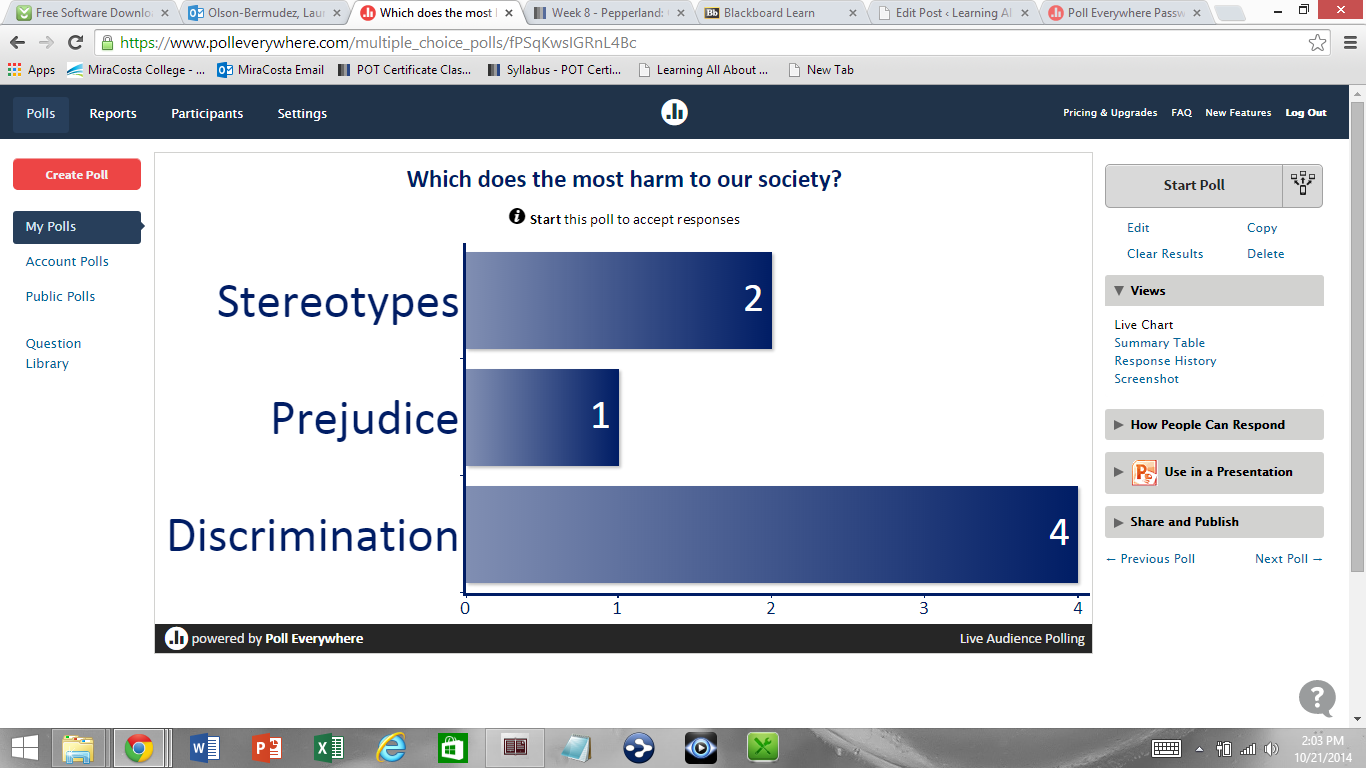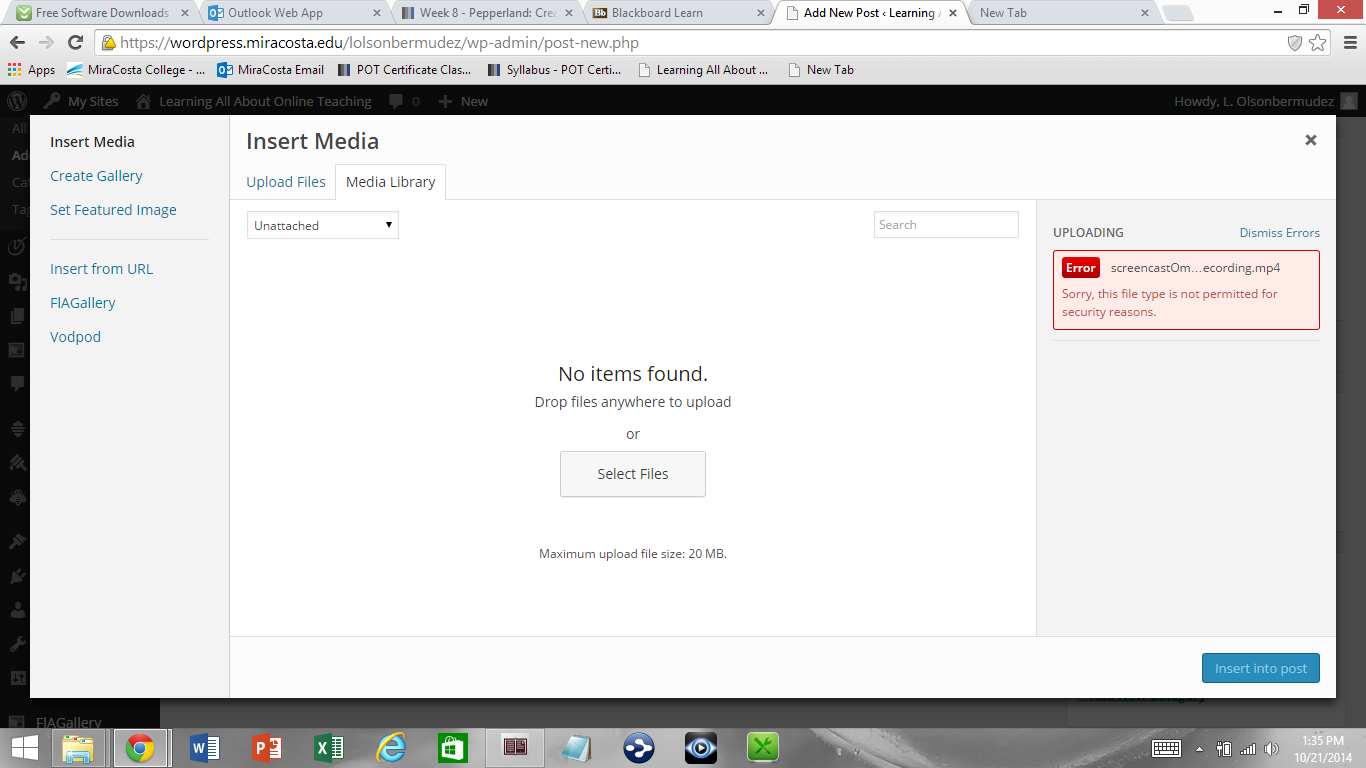Click on the “Week # Post” to view each one. Each week’s post is filled with my efforts – time and energy. Over the weeks, I notice they become more sophisticated, less fraught with anxiety about the technology. I put in significant hours each week watching the tutorials and reading the assignments and posting to my blog. I took notes on all the readings and often times watched video clips 2 or 3 times (or more), until I really understood the content and process. While I did make comments on colleagues’ posts, I didn’t have the most insightful posts, as the process was new to me. I tested out facebook, Diigo, and Twitter, but I did not spend quality time on those sites.
Reflections: My post is a brief introduction in which I share that I am a beginner when it comes to online teaching. Reflecting back, I was really learning the basics, even the language was new to me, LMS, PLN, wikis, etc.
Reflections: My post is honest and thoughtful and reflects a bit of lingering frustration as access was not so easy for me initially. However, I was able to embed pictures into my blog for the first time, and I realize, “I think I can do this.”
Reflections: In this detailed post, I am connecting the information from the week directly to my current classes. I reflect on the links I use and create my first link in the blog. I continue to practice embedding pictures into my blog. I was pleased to be able to check out the sample classes online and I especially enjoyed looking over Pilar’s class.
Reflections: I spent a lot of time on the content in week 4, which is reflected in my lengthy post :). I played around with formatting, and embedded a youtube video, added a link and posted a picture. At this point, it is all still new, but I am doing it. There is less frustration for me and I feel like I am catching on. When I struggled with adding a link, I was guided by a colleague and re-posted the link successfully in the 2nd post for week 4. I am becoming more independent and using the internet to search for help when I need it.
Reflections: The quality of my post this week is creative and thoughtful (and lengthy again). I have so much to write about as I think about all the elements that I would include in an online class. I start to question the use of different technologies here. I can see my process evolving, I am feeling overwhelmed by learning all the new technology, that my tendency is to want to lesson my technology load in hopes of decreasing my anxiety. I am a bit reluctant to actually use twitter, even though I signed up for an account. However, my post is insightful and loaded with content. I continued to practice my skill of adding in links and pictures :).
Reflections: The learning for me in week 6 is centering around having pedagogy for every class activity, and I discuss that in detail with examples. I continue to explore different technologies (diigo) and recognize for the first time that students in online classes need extra time to navigate the course and assignments.
Reflections: The information on copyright and free resources was really eye opening. I thoughtfully blogged about issues related to classes I am currently teaching. I expressed concerns about academic integrity and plagiarism as well. I continue to reflect on the material we read about each week and relate it back to my experiences in the classroom.
Reflections: In week 8, I reflect on the many different resources available to online teachers, remembering that pedagogy should be your guide to the tools that you use. I shared my own use of polleverywhere.com and how it really adds to the student learning. I embed a screen shot this week and then try screencastOmatic for the first time. I was grateful for the guidance I received from Joanne in uploading my video to wordpress. Each week, I put a great deal of time and thought into this blogging process.
Reflections: I learned about Survey Monkey and developed my first set of FAQ’s for my classes with this blog. What a great exercise, really got me reflecting on how I present assignments to my class, even how I review the syllabus with them. Is this the week we watched that brief Youtube video where MCC students talk about what you need to do as a student to be successful? Love that video and will use it in future classes. Here it is!
https://www.youtube.com/watch?v=SY0hCiZRev0
Reflections: This was perhaps my favorite blog, filled with reflective thinking, insights, and application to real world. I could absolutely identify with being a technology novice and the issues surrounding that. I am reading the materials and as I do so, I am coming up with new ideas in my head, which I shared in my post. At this point in the semester, I am feeling confident with the content and theory.
Reflections: In week 11, I am really concentrating on my pedagogy, bringing in examples of what works and what does not work in the classroom based on my experience. I share an example of an assignment I give, and talk about how I will improve upon this activity next time I teach the class. I use a screenshot to display the assignment that I post on Blackboard.
Reflections: During this week, I reflect on my use of technology and collaborative/group work in my classes. I am motivated to change some assignments for my next class into collaborative projects, utilizing more small groups and peer feedback. I would like to add different elements into my class next semester, including students presentations using video or power point and having students run discussions.
Reflections: I share my excitement for my insights in this week’s post. I have a clear picture of what is working in my classes and what I need to add more of. I learn that reflective thinking is crucial to deeper learning, and start to think of more ways I can incorporate that into my classes. Through readings and videos, I am starting to have a deeper appreciation for the use of twitter (and blogging). I relate those things to what I am familiar with in the field of psychology. I am using reflective thinking to understand these POT concepts :).
Reflections: Building upon my insights of the importance of reflective thinking and meaningful, long term learning, I created a 6 minute Youtube presentation on The Use Of Blogs to Enhance Reflective Learning. I enjoyed reading about the topic and demonstrated how these concepts can be used in my Lifespan Development class to make it better :). When I watch my presentation over, I realize I sound nervous in the beginning, and slowly relax as I get into the presentation. It is my first official Youtube presentation (other than the 1 minute sample earlier in the semester). I hope I will sound more relaxed throughout my entire recording next time I do this. I benefited greatly from taking this class. “The more you put into something, the more you get out of it.” – So true! I am more aware of and focused on theory, collaborative student learning, the importance of reflection, and of course the technology all around. Also, “the more you learn, the less you really know.” I realize that I have a lot more learning to do in this field. I am eager to jump in and teach in the online field.





